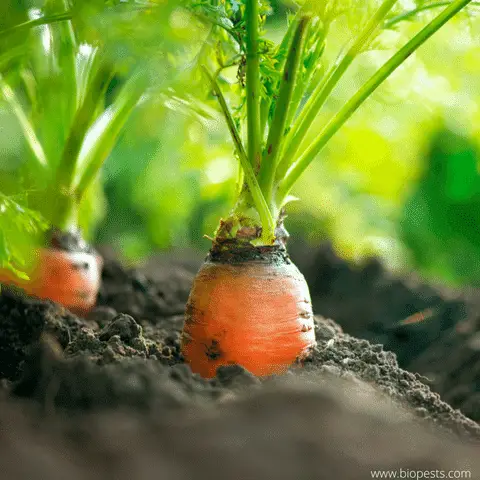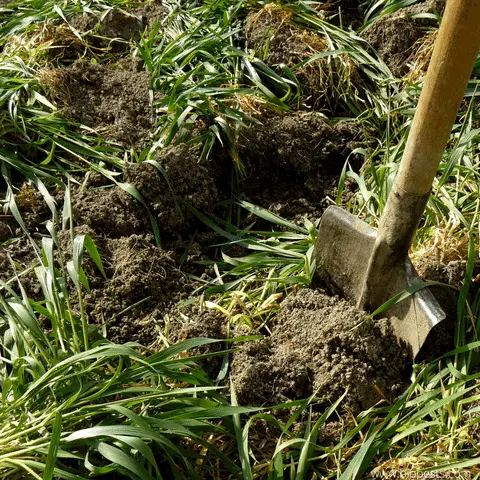Carrots are one of the most common and loved vegetables, thanks to their flavor and many beneficial properties. They are rich in vitamins, and minerals and strengthen our immune system. These are just a few of the reasons why growing carrots is a must for any gardener and they can’t be missing from the vegetables we grow in our garden.
Generally speaking, carrot cultivation is quite simple. Sometimes, however, things don’t go as planned, and although you have taken all the necessary steps to grow carrots “by the book”… you end up with “hairy” and uninviting-looking carrots.
After all the hours of work you’ve invested in your carrots, ending with such a crop is undoubtedly frustrating.
Surely, the first question you ask yourself is if they are edible or if they should be thrown away.

Are Hairy Carrots Safe To Eat?
Luckily for us, a hairy carrot is safe to eat. Its hairy looks only affect its appearance. Its numerous little white roots have no relevance from a nutritional point of view, they won’t harm you as long you remove them with a peeler before consumption.
Hairy carrots will taste no different than a normal carrot.
What Causes Carrots To Be Hairy?
An excess of nitrogen in the carrot soil or fertilizer is the cause of hairy roots in carrots. This affects the vegetable during growth and causes an increase in the foliar apparatus, developing hairy roots, splitting of the roots, and a decrease in the carotene content.
How Can I Prevent My Carrots From Becoming Hairy?
The formation of hairy roots in carrots depends solely on the conditions of the soil. The best way to prevent hairy root growth is to prepare the soil before sowing carrots.
Let’s dive deeper into the subject.
What Kind Of Soil do Carrots Need In Order To Grow Healthy?
If you want to get good results when harvesting carrots it is necessary you pay particular attention to the soil of your vegetable garden/raised bed.
The ideal soil to grow carrots is light, sandy, and aerated soil, with a pH between 6.5 and 7.5. Growing carrots under these conditions will prevent carrot growth problems such as deformed, forked root formation.
Heavy clayey and compact soil that is poorly drained is not suitable for growing carrots.
Also, carrots poorly tolerate acidic soil.
The ideal would be to plant carrots outdoors, in sunny and ventilated areas. This will discourage dangerous pests such as the carrot fly. Another important factor to take into consideration when preparing the soil is that it should not contain fresh manure. Besides the fact that it may contain eggs and larvae that are harmful to the carrots, fresh manure is also too strong since it contains high levels of nitrogen, which can burn and kill the young plant.
How To Prepare The Soil To Grow Healthy Carrots?
The preparation of the soil for the cultivation of carrots is done in this order:
- Plan where to saw carrots: The soil preparation for carrot cultivation should be planned in advance. Planting of carrot seeds is done in early spring, however, the preparation of the soil starts already in late autumn and winter. As I mentioned above, carrots prefer full sun, so make sure you grow them in a nice ventilated area with plenty of space (they don’t like crowded space). Carrots require a mild and not too hot climate because the root hardens if the temperature is too high.
- Stone removal: Once you have decided where you want to grow carrots, you need to remove all stones to make it easier for your vegetables to develop properly. The presence of stones will definitely alter their growth so don’t underestimate this step. It’s actually very important!
- Deep digging: The soil must be dug up during the autumn or winter period to facilitate aeration and make it softer. As I mentioned earlier, carrots do not like hard, compacted soil. You need to get to a depth of at least 12 inches ( 30 cm). Keep in mind that loose soil facilitates carrot harvesting once it reaches maturity! Otherwise, a heavy and clayey soil could favor the breaking of the root during the harvest phase and fade away all our efforts!
- Fertilize the soil: After all the digging, it will be necessary to fertilize the soil.

It is better to use a fertilizer high in potassium and low in nitrogen since the latter would end up favoring the development of the leaves at the expense of the underground root.
It is preferable to use compost instead of brown manure.
A widely used technique for fertilization is the application of green manure, which in addition to making the soil softer, releases a lot of potassium, an essential element for the cultivation of carrots.
Wait at least a week from the application, so that the soil can absorb all the nutrients
Carrot seeds are rather slow to germinate. You need lots of patience since it could take them up to 40 days for the first seedling to appear! It is better to plant the seeds directly in the field since carrot seedlings do not tolerate transplants. This vegetable reacts poorly when you move them from the tray into your vegetable garden: if you sow in trays and transplant the seedlings, this will later affect the development of the roots and most likely you will get deformed carrots.
How To Sow Carrots
We have seen that carrots are very demanding when it comes to the quality of their soil, while as regards the sowing period, they are less picky. In fact, carrots could potentially be sown almost all year round.
Carrots are generally sown in early spring, from March to June.
You need to create rows by creating a distance of at least 10 inches (25 cm) from one row to the other. The seed must be buried at a maximum depth of half an inch (1 cm) and the distance between one plant to another must be at least 3 inches (8 cm) along the row.
Carrots seeds are tiny and it takes them a long time to germinate. In order to speed up the process, you can soak the seeds in warm water or in chamomile a few hours before sowing.
Do I Need To Keep Fertilizing The Soil After Planting Carrots?
Carrots are avid feeders.
Keep Fertilizing the soil with a low in nitrogen but high in potassium and phosphate fertilizer 5 to 6 weeks after planting. Remember that excess nitrogen in the soil promotes the growth of foliage, and hairy roots, not the carrots themselves!
Carrots Fun Fact!
One thing not everyone knows is that carrots were originally not orange but … purple! The current orange color spread following a selection made by some Dutch growers in 1600, in honor of William of the Orange-Nassau, ancestor of the current Dutch royal house. The success was such that nowadays, orange carrots are the norm, while purple ones are considered a rarity!
Conclusion
In short, growing carrots is simple, just follow these small steps to ensure a good harvest. Don’t be discouraged if your carrots don’t look exactly like those sold in the supermarket, the important thing is that they are grown in good soil, rich in nutrients. For the rest, nothing that cannot be solved with a good peeler…
If you have been growing carrots with no success you might be interested in reading about the symptoms of root-knot nematodes here.
Some of the links above are affiliate links, meaning, at no additional cost to you, I will earn a commission if you click through and make a purchase.

